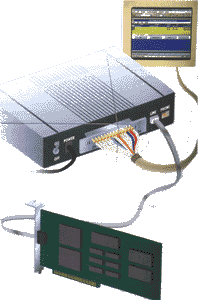 MODEM
MODEM
|
|
 |
1]
Your communications software sends a voltage along pin 20 of the serial
port to which the modem is connected. The voltage is called a data Terminal
Ready signal, or simply, a DTr siganl. It tells the modem that the PC
is turned on and ready to tranmit dtata. At the same time, the PC detects
a voltage from the modem on pin 6 - Data Set Ready, or DSR signal- that
lets the PC know the modem is ready to receive data or instructions. Both
signals must be present before anything else can happen.
2]Using a standard command language named after the Hayes modems on which it was first popularized, the communications software sends a command to the modem via line 2, the Transmit Data line. The command telss your modem to go off hook - to open a connection with the phone line. The software follows with another Hayes command that tells the modem to issue the tones or pulses needed to a dial a specific phone number. The modem acknowledges the command by replying to the PC on line 3, the Receive Data line. |
|
3]
When the modom on the other end of the phone connection-the remote modem-answer
the call, your local modem sends out a hailing tone to let the reemote
modem know that it's being called by another modem. The remote modem responds
with a higher-pitched tone. (Youcan ordinarily hear the two tones if your
modem is equipped with a speaker.)
4]When communications are established your modem sends your PC a Carrier Detect (CD) signal online 8. The signals tell the communications software that the modem is receiving a carrier signal, whicxh is a steady tone of a certain frequnecy that later will be modulated to transmit data. 5] The two modems exchange information about how they'll send data to each other, a process called a handshake. The two modems must agree on the transfer speed, the number of bits that make up a data packet, how many bits will signal the beginning and end of a packet, whether they will operate at half-duplex of full duplex. If the local and remote systems do not use the same settings, either they'll wind up sending characters that make no sense or they'll refuse to communicate at all. 6] When the communications software wants to send data, it first sends voltage to line 4 on the serialport. This Request to SDend (RTS) signal, in effect, asks if the modem is receiving remote data it wants to pass on to your PC is busy doing something else- such as saving earlier data to disk -the PC will turn off the RTS signal to tell the modem to stop sending it data until the PC finishes its other work. 7] Unless your modem is too busy handling other data to receive new data from your system, it return a Clear to Send (CTS) signal to your pc responds by sending the data to be trasmitted on line 2. The modem sends data it received from the remote system to your PC via line 3. If the modem cannot trasmit the data as fast as your PC sends data to it, the modem will drop the CST signal to tell your PC to hold off any on any further data until the modem catches up and renews the signal. 8] At the other end of the phone line, the remote modem hears incoming data as a series of tones with different frequencies. It demodulates these tones back into digital signals and sends them to the receiving computer. Actually, both computers can send signals back and forth at the same time because the use of as standard ysytem of tones allows modems on either end to distinguish between incoming and outgoing signals. |